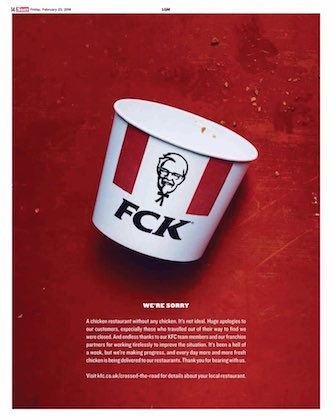KFC Insider Tells All on Maintaining Brand Voice in Chicken-Shortage Crisis

One of the biggest and best-handled crises of the year was KFC’s chicken shortage in the U.K. and Ireland. Now, 10 months after the incident, we have an inside account from a KFC team member. A major theme that comes through for communicators is the importance of maintaining a brand’s voice in a crisis.
KFC (formerly Kentucky Fried Chicken) got into trouble in February when it switched chicken suppliers only to learn that the new supplier — Deutsche Post-owned DHL — couldn’t supply.
The restaurant chain, owned by Zum Brands Inc., shut down 750 of its 900 stores in the U.K. and Ireland. It turned to social media and ads to poke fun at itself but also to keep customers informed as to what was happening. “The Chicken Crossed the Road, Just Not to Our Restaurants,” it apologized.
The press and public response, including from us, was extremely positive. The huge accolades came when KFC ran newspaper ads about the situation featuring a picture of one of its famous buckets — empty — plastered with an anagram of its name: FCK. In June, the print campaign won a Cannes Lion award.
On Nov. 6, Jenny Packwood, KFC’s head of brand engagement for the U.K. and Ireland, spoke at Cision’s CommsCon in London about the crisis response. Packwood spoke about the need to keep true to the brand’s voice.
Comfortable Thing
“So often when [a] crisis hits, the easy and most comfortable thing is to retract into that safe corporate space where you do a terribly formal statement and everything sounds like it is written by a lawyer,” Packwood said, according to PRWeek.
KFC had developed a lighthearted and irreverent voice in the U.K., and it decided to stick to it, even in its crisis response. That even extended to the famous bucket ad, Packwood said: “It gave us a way of saying sorry in a bold and human way, and in a way that felt true to our brand.”
Obviously, it worked.
Packwood also gave a concrete take on the size of the chicken-shortage crisis. “We took 321 media enquiries over the first seven days — that is half of our annual average,” she said. “There were over 1,000 pieces of coverage globally across print, online and broadcast and 80 percent of all UK adults were exposed to this story, although I always question what the other 20 percent were doing.”
That’s the sort of dimensions all crisis communicators must be prepared for.
This is an abridged version of an article that appeared today on the CrisisResponsePro paid subscription portal. (CrisisResponsePro subscribers can access the full version by clicking here. ID and password are required.) To take advantage of all of the content, data, and collaborative resources CrisisResponsePro has to offer, contact us at info@crisisresponsepro.com.




 Back to Blog
Back to Blog